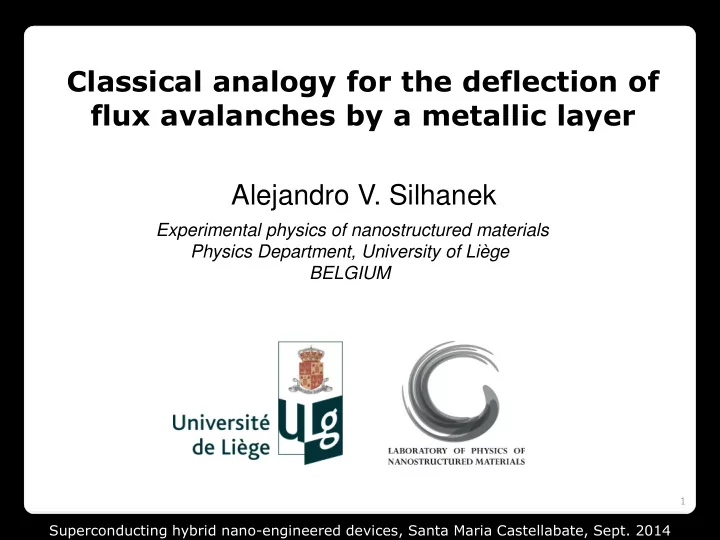

Classical analogy for the deflection of flux avalanches by a metallic layer Alejandro V. Silhanek Experimental physics of nanostructured materials Physics Department, University of Liège BELGIUM 1 Superconducting hybrid nano-engineered devices, Santa Maria Castellabate, Sept. 2014
Collaborators J Brisbois, O-A Adami, B Vanderheyden, N D Nguyen Université de Liège, BE B Hackens, Université Catholique de Louvain, BE F Colauto, M Motta, W A Ortiz, Universidade Federal de Saõ Carlos, BR J Fritzsche, Chalmers University of Technology, SE 2
Magnetic flux avalanches D M >> D T D T >> D M Q Heat transport by phonons can be ruled out adiabatic conditions, hence Δ T = Q / C (T) Flux T motion v ~160 km/s >> sound velocity 7 km/s v Abrikosov << 1 km/ s v kinematics ~ 100 km/ s v josephson-vortex ~ 10000 km/s Jc, F p 3 R. G. Mints and A. L. Rakhmanov, Rev. Mod. Phys. 53 , 551 (1981)
Cu coating of superconducting solenoids Q Flux T motion Jc, F p 4 Kim Y B, Stephen M J and Parks R D 1969 Superconductivity vol 2
Suppression of flux avalanches METALLIC SHEET SUPERCONDUCTOR “The clear sensitivity of dendritic avalanches to the thickness of the gold layer suggests a thermal origin for the instability” 5 M. Baziljevich, Physica C 369 (2002) 93 – 96; Choi et al. Appl. Phys. Lett. 87 , 152501 (2005)
Deflection of flux avalanches Change of propagation direction depending on the incident angle. The gold capping reduces the velocity v of the avalanches. The propagation of an avalanche gives rise to large electric fields according to Faraday’s law that cause high currents in the gold film . 6 J Albrecht et al. (2005) Appl. Phys. Lett. 87 182501
Magnetic braking of flux avalanches “Flux jumps are strongly suppressed when a metallic layer is located close — but not necessarily in contact. The effect is due to eddy currents induced in the metal preventing by electromagnetic braking large-scale vortex avalanches to develop." 7 Colauto et al. (2010) Appl. Phys. Lett. 96 , 92512
Magnetic braking of vortices in semiconductor/superconductor hybrids “significant additional damping of vortex motion caused by the eddy currents generated in the 2D electron gas” F D DEG 2 T SC 2 DEG SC v d n F D v 8 Danckwerts et al. (2000) Phys. Rev. Lett. 84, 3702; Baker and Rojo (2001) Phys. Rev. B 64, 14513
Research objectives What if the metallic layer is not covering the superconductor’s borders ? May a single vortex also undergo deflection when entering the region covered by the metallic layer ? Can we think of a classical model mimicking the observed behavior ? 9
Avalanche exclusion No thermal shunt at the nucleation point of the avalanches Exclusion of flux avalanches by the Cu layer In the smooth (critical state) flux penetration regime, there is no difference between the sample with or without the Cu triangle ZFC 2.5K, 20 Oe ZFC 7K, 15 Oe 10 Brisbois et al. arXiv:1408.2420v1
Classical model 11 Brisbois et al. arXiv:1408.2420v1
Eddy currents and image method m m
Eddy currents and image method m v
Classical model w w w Low velocity High velocity 14 Rossing T D and Hull J R 1991 Phys. Teach. 29 552-562 | W.M.Saslow, Am J. Phys. 60 , 693 (1992)
Classical model ~0,1 km/s ~1 km/s F LO 1,0 2 v v 1 F D / F max v * 0,5 0,0 0 2 4 6 8 v / v * 15 Brisbois et al. arXiv:1408.2420v1 W.M.Saslow, Am J. Phys. 60 , 693 (1992)
Classical model 16 Borcherts R H and Davis L C 1972 J. Appl. Phys. 43 2418
Boundary effect 17 Borcherts R H and Davis L C 1972 J. Appl. Phys. 43 2418 | Davis L C and Reitz J R 1971 J. Appl. Phys. 42 4119
Vortex trajectories 18 Brisbois et al. arXiv:1408.2420v1
Conclusion We are able to explain in classical terms the deflection of magnetic flux by a conducting layer Our classical analogy suggests a non-monotonous F D ( v ) relation Typical MOI experiments need an Al mirror of about 200nm. Does this mirror influence the measurements? Next step: what about replacing the Cu layer by a superconducting film? How LO instabilities are affected by a metallic layer? 19 Brisbois et al. arXiv:1408.2420v1
Thank you 20
Supplementary slides 21
Recommend
More recommend